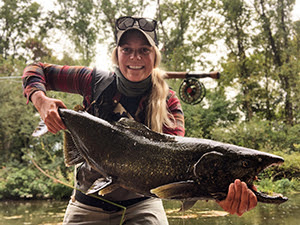
|
Every fall Pacific (coho and Chinook) salmon migrate up the Salmon River to make the trip back to the hatchery where their life began, but not all these fish are hatchery fish. There’s actually a large amount of natural reproduction of Chinook salmon that takes place in the river. Wild Chinook, many of which are produced in the Salmon River, are an important component of the Lake Ontario fishery, contributing up to 70 percent of the Chinooks produced in a given year. Wild Chinook tend to spawn in the river, and most of the Chinook returning to the hatchery are of hatchery origin. The main stem of the Salmon River gets a bit warm in the summer for young salmon but Chinook hatch in May and are gone to Lake Ontario by the end of June. Successful reproduction of coho salmon (and steelhead) is largely limited to the cooler tributaries (Trout and Orwell Brooks) due to their longer river residence and requirement of year-round juvenile habitat.
The Salmon River, located in Oswego County, stretches 17 miles from the Lighthouse Hill Reservoir in Altmar to where it empties into Lake Ontario at Port Ontario. There are 12 miles of Public Fishing Rights along the river. The Salmon River offers some of the finest sportfishing in the country. Two major fish records have been set in the Salmon River: the Great Lakes record Chinook salmon (47 lbs. 13 oz.) and the world record Coho salmon (33 lbs. 4 oz.).
The recently completed Salmon River Fisheries Management Plan (PDF), which was developed with stakeholders input, provides succinct descriptions of the river's trout and salmon fisheries and lays out the framework of major objectives and the strategies which the Department intends to employ to meet the Plan's stated goal: "DEC will manage the River and its tributaries as a premier, high quality, year-round sport fishery with the opportunity to catch a diversity of trophy sized lake run trout and salmon species". The Plan calls for development of a yearly workplan (PDF) to guide actions and to share with stakeholders at annual "State of the Salmon River Fishery" meetings.
A complimentary plan titled the Lower Salmon River Restoration and Recreation Enhancement Plan (PDF) was also recently completed and provides a more detailed description of the history of the river and its fishery. The management objectives of this plan primarily cover the 1,700 acres of recently acquired state property which borders much of the river between the Lighthouse Hill Reservoir and the Village of Pulaski. The purpose of acquiring these lands was to improve and ensure protection of the natural resources, construct several restoration structures to stabilize river banks and improve aquatic habitat, and to improve public access to the rivers world class fisheries.